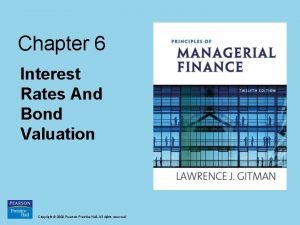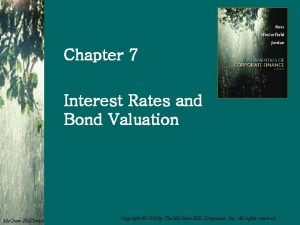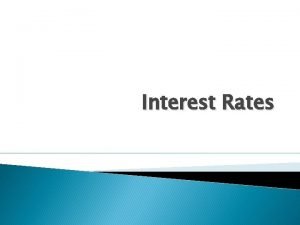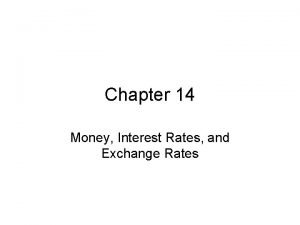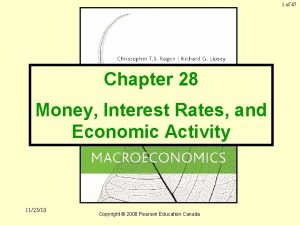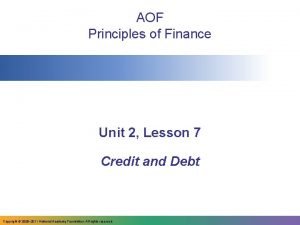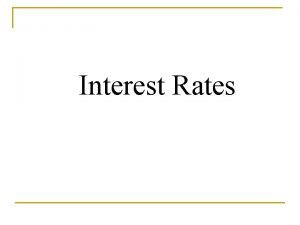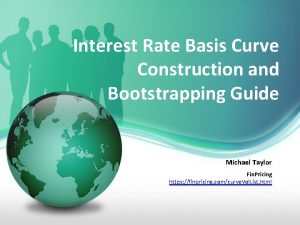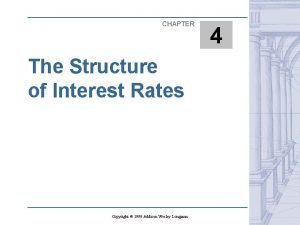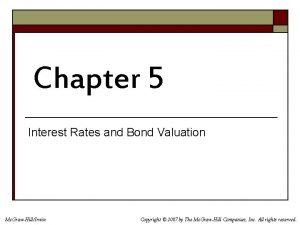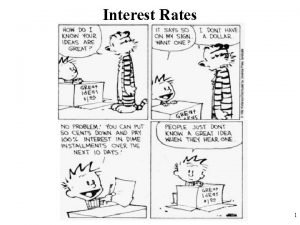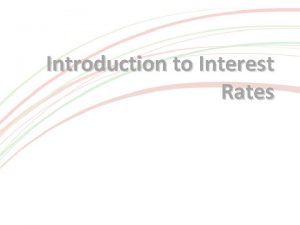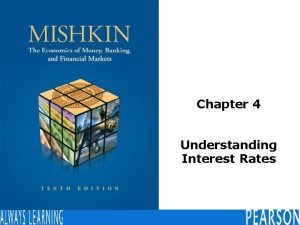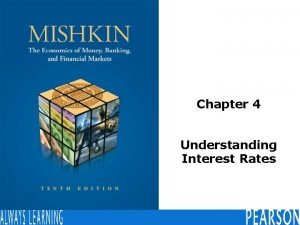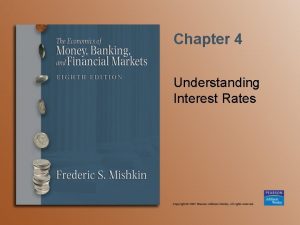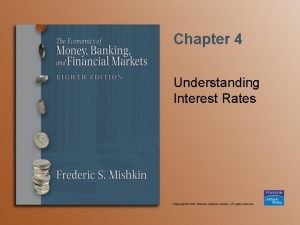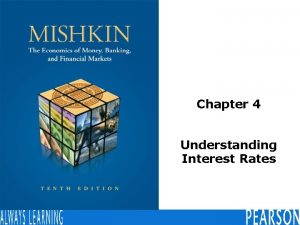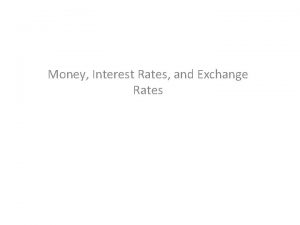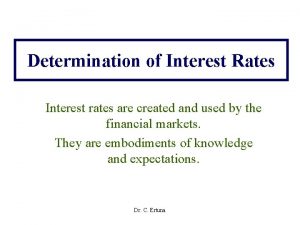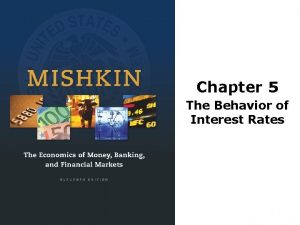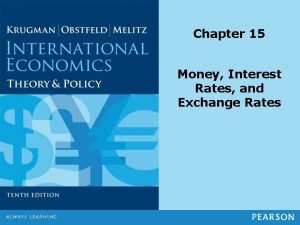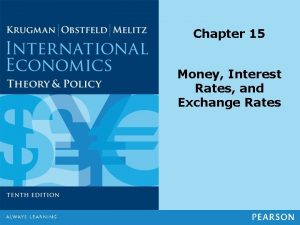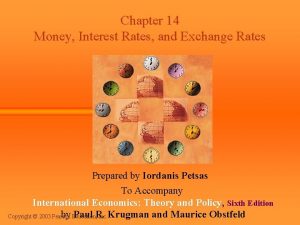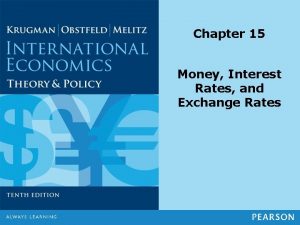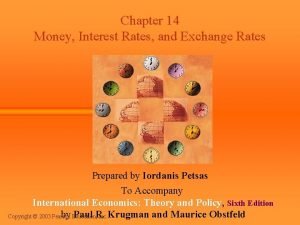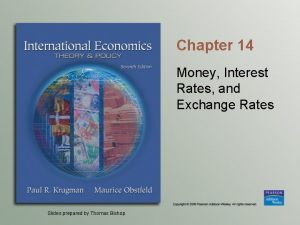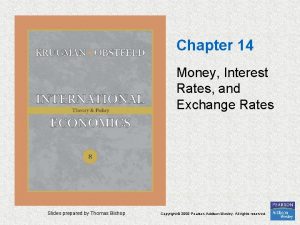Chapter 4 The Meaning of Interest Rates Preview























- Slides: 23

Chapter 4 The Meaning of Interest Rates

Preview • Before we can go on with the study of money, banking, and financial markets, we must understand exactly what the phrase interest rates means. In this chapter, we see that a concept known as the yield to maturity is the most accurate measure of interest rate. 4 -2 © 2016 Pearson Education, Inc. All rights reserved.

Learning Objectives • Calculate the present value of future cash flows and the yield to maturity on the four types of credit market instruments. • Recognize the distinctions among yield to maturity, current yield, rate of return, and rate of capital gain. • Interpret the distinction between real and nominal interest rates. 4 -3 © 2016 Pearson Education, Inc. All rights reserved.

Measuring Interest Rates • Present value: a dollar paid to you one year from now is less valuable than a dollar paid to you today. – Why: a dollar deposited today can earn interest and become $1 x (1+i) one year from today. 4 -4 © 2016 Pearson Education, Inc. All rights reserved.

Present Value 4 -5 © 2016 Pearson Education, Inc. All rights reserved.

Simple Present Value 4 -6 © 2016 Pearson Education, Inc. All rights reserved.

Simple Present Value • Cannot directly compare payments scheduled in different points in the time line Year PV 4 -7 $100 0 1 2 n 100/(1+i)2 100/(1+i)n © 2016 Pearson Education, Inc. All rights reserved.

Four Types of Credit Market Instruments • • 4 -8 Simple Loan Fixed Payment Loan Coupon Bond Discount Bond © 2016 Pearson Education, Inc. All rights reserved.

Yield to Maturity • Yield to maturity: the interest rate that equates the present value of cash flow payments received from a debt instrument with its value today 4 -9 © 2016 Pearson Education, Inc. All rights reserved.

Yield to Maturity on a Simple Loan 4 -10 © 2016 Pearson Education, Inc. All rights reserved.

Fixed-Payment Loan 4 -11 © 2016 Pearson Education, Inc. All rights reserved.

Coupon Bond 4 -12 © 2016 Pearson Education, Inc. All rights reserved.

Coupon Bond • When the coupon bond is priced at its face value, the yield to maturity equals the coupon rate. • The price of a coupon bond and the yield to maturity are negatively related. • The yield to maturity is greater than the coupon rate when the bond price is below its face value. 4 -13 © 2016 Pearson Education, Inc. All rights reserved.

Coupon Bond • Consol or perpetuity: a bond with no maturity date that does not repay principal but pays fixed coupon payments forever For coupon bonds, this equation gives the current yield, an easy to calculate approximation to the yield to maturity 4 -14 © 2016 Pearson Education, Inc. All rights reserved.

Discount Bond 4 -15 © 2016 Pearson Education, Inc. All rights reserved.

The Distinction Between Interest Rates and Returns • 4 -16 Rate of Return: © 2016 Pearson Education, Inc. All rights reserved.

The Distinction Between Interest Rates and Returns • The return equals the yield to maturity only if the holding period equals the time to maturity. • A rise in interest rates is associated with a fall in bond prices, resulting in a capital loss if time to maturity is longer than the holding period. • The more distant a bond’s maturity, the greater the size of the percentage price change associated with an interest-rate change. 4 -17 © 2016 Pearson Education, Inc. All rights reserved.

The Distinction Between Interest Rates and Returns • The more distant a bond’s maturity, the lower the rate of return the occurs as a result of an increase in the interest rate. • Even if a bond has a substantial initial interest rate, its return can be negative if interest rates rise. 4 -18 © 2016 Pearson Education, Inc. All rights reserved.

The Distinction Between Interest Rates and Returns 4 -19 © 2016 Pearson Education, Inc. All rights reserved.

Maturity and the Volatility of Bond Returns: Interest-Rate Risk • Prices and returns for long-term bonds are more volatile than those for shorter-term bonds. • There is no interest-rate risk for any bond whose time to maturity matches the holding period. 4 -20 © 2016 Pearson Education, Inc. All rights reserved.

The Distinction Between Real and Nominal Interest Rates • Nominal interest rate makes no allowance for inflation. • Real interest rate is adjusted for changes in price level so it more accurately reflects the cost of borrowing. – Ex ante real interest rate is adjusted for expected changes in the price level – Ex post real interest rate is adjusted for actual changes in the price level 4 -21 © 2016 Pearson Education, Inc. All rights reserved.

Fisher Equation 4 -22 © 2016 Pearson Education, Inc. All rights reserved.

Figure 1 Real and Nominal Interest Rates (Three-Month Treasury Bill), 1953– 2014 Sources: Nominal rates from Federal Reserve Bank of St. Louis FRED database: http: //research. stlouisfed. org/fred 2/. The real rate is constructed using the procedure outlined in Frederic S. Mishkin, “The Real Interest Rate: An Empirical Investigation, ” Carnegie. Rochester Conference Series on Public Policy 15 (1981): 151– 200. This procedure involves estimating expected inflation as a function of past interest rates, inflation, and time trends, and then subtracting the expected inflation measure from the nominal interest rate. 4 -23 © 2016 Pearson Education, Inc. All rights reserved.
 Chapter 7 interest rates and bond valuation
Chapter 7 interest rates and bond valuation Chapter 5 bonds bond valuation and interest rates solutions
Chapter 5 bonds bond valuation and interest rates solutions Chapter 6 interest rates and bond valuation
Chapter 6 interest rates and bond valuation Chapter 7 interest rates and bond valuation
Chapter 7 interest rates and bond valuation Chapter 6 interest rates and bond valuation
Chapter 6 interest rates and bond valuation Unit ratio
Unit ratio Equivalent ratios
Equivalent ratios Ratios rates and unit rates
Ratios rates and unit rates Ratios rates and unit rates
Ratios rates and unit rates Ssema
Ssema Expansionary fiscal policy graph
Expansionary fiscal policy graph Disadvantages of high interest rates
Disadvantages of high interest rates Interest rate quotes
Interest rate quotes Increase money supply
Increase money supply Interest rates and price level
Interest rates and price level Nominal.interest rate
Nominal.interest rate Determinants of interest rates
Determinants of interest rates Personal finance unit 2 lesson 2
Personal finance unit 2 lesson 2 Real vs nominal interest rate
Real vs nominal interest rate Interest rates
Interest rates Interest rate curve construction
Interest rate curve construction Interest rates
Interest rates Interest rates
Interest rates Shifters of demand for loanable funds
Shifters of demand for loanable funds


